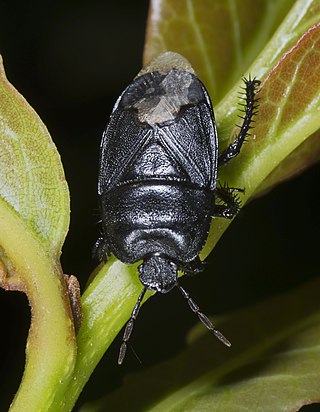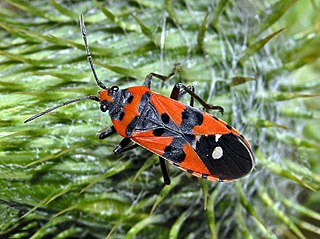
The Malvales are an order of flowering plants. As circumscribed by APG II-system, the order includes about 6000 species within nine families. The order is placed in the eurosids II, which are part of the eudicots.

Black-and-white colobuses are Old World monkeys of the genus Colobus, native to Africa. They are closely related to the red colobus monkeys of genus Piliocolobus. There are five species of this monkey, and at least eight subspecies. They are generally found in high-density forests where they forage on leaves, flowers and fruit. Social groups of colobus are diverse, varying from group to group. Resident-egalitarian and allomothering relationships have been observed among the female population. Complex behaviours have also been observed in this species, including greeting rituals and varying group sleeping patterns. Colobi play a significant role in seed dispersal.

Welwitschia is a monotypic genus of gymnosperm, the sole described species being the distinctive Welwitschia mirabilis, endemic to the Namib desert within Namibia and Angola. Welwitschia is the only living genus of the family Welwitschiaceae and order Welwitschiales in the division Gnetophyta, and is one of three living genera in Gnetophyta, alongside Gnetum and Ephedra. Informal sources commonly refer to the plant as a "living fossil".

Friedrich Martin Josef Welwitsch was an Austrian explorer and botanist who in Angola was the first European to describe the plant Welwitschia mirabilis. His report received wide attention among the botanists and general public, comparable only to the discovery of two other plants in the 19th century, namely Victoria amazonica and Rafflesia arnoldii.

Pyrrhocoridae is a family of insects with more than 300 species world-wide. Many are red coloured and are known as red bugs and some species are called cotton stainers because their feeding activities leave an indelible yellow-brownish stain on cotton crops. A common species in parts of Europe is the firebug, and its genus name Pyrrhocoris and the family name are derived from the Greek roots for fire "pyrrho-" and bug "coris". Members of this family are often confused with, but can be quickly separated from, Lygaeidae by the lack of ocelli on the top of the head.

Pentatominae is a subfamily of Pentatomidae, a family of shield bugs. This subfamily is the largest one within the Pentatomidae, having 4937 species classified in 938 genera. Species in this subfamily are phytophages and several of them are considered agricultural pests. Some invasive pentatomines such as Halyomorpha halys and Bagrada hilaris have been considered household pests. Higher systematics of the group have been revised by Rider et al.

Nysius is a genus of false chinch bugs in the family Lygaeidae. At least 100 described species are placed in Nysius.

Cydnidae are a family of pentatomoid bugs, known by common names including burrowing bugs or burrower bugs. As the common name would suggest, many members of the group live a subterranean lifestyle, burrowing into soil using their head and forelegs, only emerging to mate and then laying their eggs in soil. Other members of the group are not burrowers, and live above the soil layer, often in close association with plants. Several species are known as agricultural pests.

The subfamily Aphaeninae is a group of hemipteran insects, especially abundant and diverse in the tropics. They belong to the Fulgoridae (fulgorids), though they are not among the better-known members of that family that are called "lantern bugs" or "lanternflies". In 2009, the first molecular analysis of the Fulgoridae challenged the existing structure of eight currently recognized subfamilies and eleven tribes.

Gerrardina is a genus of two species of trees, shrubs, and scrambling shrubs found in southeastern Africa. Until recently, the genus was placed in the polyphyletic family Flacourtiaceae, but it was abnormal there due to its apical placentation, small embryos, and mucilaginous foliar epidermis. Analyses of DNA data indicated that the genus did not fit in any known plant family and not clearly in any then-recognized order, and a new family, Gerrardinaceae, was thus created for it. Later analyses of additional DNA data and data from wood anatomy indicated that the family should be placed in the order Huerteales.
P. angolensis may refer to:

The Blissidae are a family in the Hemiptera, comprising nearly 50 genera and 400 species. The group has often been treated as a subfamily of the Lygaeidae but was resurrected as a full family by Thomas Henry (1997).
Probergrothius sexpunctatus is a species of true bug found in West-Central Africa. The name has been misattributed for many decades to a related species, Probergrothius angolensis, a species that occurs farther to the south, and which feeds on the Welwitschia plant.

Probergrothius angolensis, sometimes known as the Welwitschia bug, is a species of true bug found in the Namib desert and nearby regions.

Lygaeus is a genus of seed bugs in the family Lygaeidae. There are more than 60 described species in Lygaeus.

Oncopeltus is a genus of seed bugs in the family Lygaeidae, which has at least 40 described species.

Probergrothius sanguinolens is a species of bug found in India. They feed on a range of seeds and are particularly common on the seeds of Sterculia and other Malvaceae. They also feed on freshly dead animal matter with early instar nymphs preferring animal matter to seeds.

Probergrothius nigricornis is a species of bug found in tropical Asia. They feed primarily on the seeds of Malvales.

Lycorma imperialis is a planthopper indigenous to parts of China and Indo-Malaysia. L. imperialis was originally discovered in 1846 by Adam White and has one recognized non-nominate subspecies, L. i. punicea. L. imperialis has undergone a number of reclassifications since its discovery and is one of four species in the genus Lycorma. L. imperialis follows a hemimetabolous life cycle and will undergo a series of nymphal stages (instars) before maturing to an adult.

Flatida is a genus of planthoppers in the family Flatidae and tribe Phromniini. Much of the literature on this genus refers to the name Phromnia, which has recently been recognized to be a junior synonym of Flatida. Species from the genus are found in tropical Africa and Asia.


















